In case you haven’t noticed, we have some killer online courses at Foundr.
Every month across the globe, hundreds of thousands of people are taking our online courses to up-skill and level up their entrepreneurial game through online course creation. And now, we are ready to show you how you can sell your course without paid ads or a following.
We’re taking it back to the basics, and teaching you how to sell your course without having a huge social media following, and without pumping money into Facebook ads and promoted posts. These methods generate sales through organic means and build a following as you go.
When it comes to selling your course for free, these four stand out from the rest:
- SEO Optimation
- Utilizing Online Course Platforms
- Leveraging Facebook Groups
- Affiliates and Partnerships
We even have real-life case studies for you to see these methods in action!
Are you ready? Let’s go!
READ MORE: How to Create an Online Course Like Foundr
The Power of SEO
How does a cooking class from Gordon Ramsey sound? Or a singing lesson from Christina Aguilera? What about a course on conservation with Doctor Jane Goodall, or perhaps RuPaul teaching self-expression and authenticity? Hans Zimmer teaching music?
MasterClass saturated the market with ads that were too good to ignore. Seriously, to date, Gordon Ramsey’s Masterclass ad has hit close to 98 million views on YouTube.
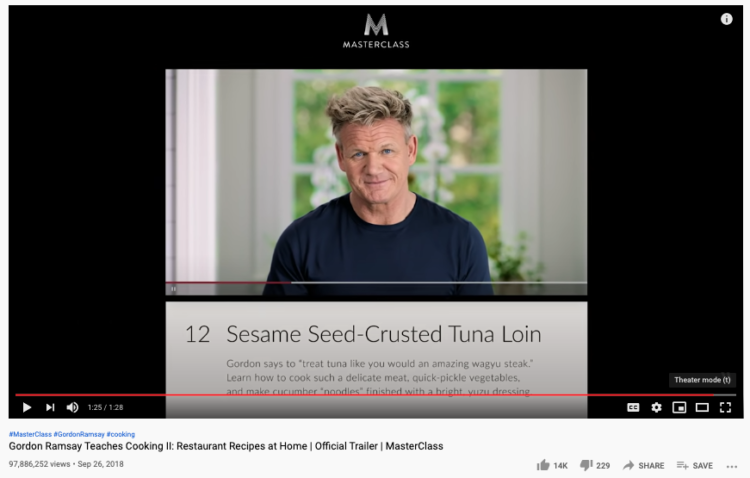
When Masterclass entered the market in 2015, it was entering into a pretty competitive space, Founders David Rogier and Aaron Rasmussen were up against giants like Udacity which had grown to a $1 billion valuation in just four years, and Coursera which had taken only three years to hit that $1 billion mark. The New York Times dubbed 2015 The Year Of The MOOC (massive open online courses), and in order to stand out, MasterClass needed to do something different.
Chris Garin says that MasterClass did what any good business should do in a crowded market: they built a distinct value proposition and clear brand positioning not to compete, but to create their own category. Rather than allowing everyone and anyone to teach a course, they chose to offer Hollywood-style productions featuring instructors who were celebrities and socially-recognized leading experts in their field.
In 2020, Bloomberg broke the news that MasterClass.com raised $100 million in a Series E round. The round was led by Fidelity Management & Research Company with participation from a bunch of new investors. MasterClass refused to disclose its new valuation but did manage to let slip that its valuation is higher than $800 million. That $800 million valuation is close to double the $410 million value estimated by Pitchbook in 2018.
So, how did MasterClass become the powerhouse it is today?
Yes, MasterClass’s success is absolutely stemmed from the celebrities they partner with (Serena Williams teaching tennis? Who wouldn’t love that?) and their course production is enough to make anyone throw money at them.
But putting aside the fact that they built their empire off their instructor’s existing following, MasterClass in itself is a masterclass in search engine optimization.
When you’re looking to promote your course, SEO keywords and search intent is the easiest way to get your course in front of potential customers. Putting celebrity names aside, the ingenuity and mastery behind MasterClass’s success is their SEO game.
Let’s explore this more.
READ MORE: Entrepreneurs Who Are Killing it With Online Courses
Why SEO Matters
Some people like to complicate SEO and make it seem like a mysterious force of nature that humankind only hopes to influence or sway.
But really, SEO at its core is just creating or designing your online course content in a way so that it shows up higher on the list of a search engine results page (SERP). Search engines, mainly Google, have certain preferences about what it likes to list first, and SEO is really just creating content that appeals to Google’s likes.
While MasterClass spends an impressive amount on their ads and course production, in fact, Business Insider estimated a $6.5 million ad spend in 2019, the bulk of their traffic comes from search. FoundationInc found that in 2019, a whopping 46% of traffic for MasterClass came from search engines.

Interestingly, MasterClass even ranks first for some of the most common search phrases which have nothing to do with online courses.
They rank in the top ten for other seemingly mundane phrases all of which show more than 100k+ search volumes. Everything from “affect vs. effect”, “fabric”, and even “turnip” which is ranking for a very impressive 4th position and a search volume of 160k.

Even if someone isn’t specifically looking for a cooking lesson, Masterclass has managed to muscle their way to the front of the search queue and show up high on the list of search-related options.
The way MasterClass has managed to dominate search is through one simple trick: they’ve focussed on search intent.
READ MORE: The Ultimate List of Every Tool You Need To Create Your Online Course
What is Search Intent?
Search intent is the goal a person has when they type a query into a search engine.
There are roughly four types of search intent:
- Informational where someone is searching for information like “who is Steve Jobs?” or “what is a gourd?”
- Navigational for where they are looking to go somewhere specific like “Facebook” or “Foundr Blog”
- Transactional is an asset to buy, use, or download like “template for invitations”
- Investigational when someone is looking to compare assets like “Apple vs. Mac” or “almond flour vs. almond meal”
When you’re looking to sell your online course, it’s more than just targeting high-volume keywords. True organic traffic is really through creating content that aligns with the person’s search intent.
Even when the user is searching for one single word, search intent is still at the core of it all. You can easily find out the intent behind someone’s search by looking at the search engine results page (SERP). Not only is it pretty cohesive, but it’s also free to do!
Have a look below at the most common search intents behind “baking soda”.
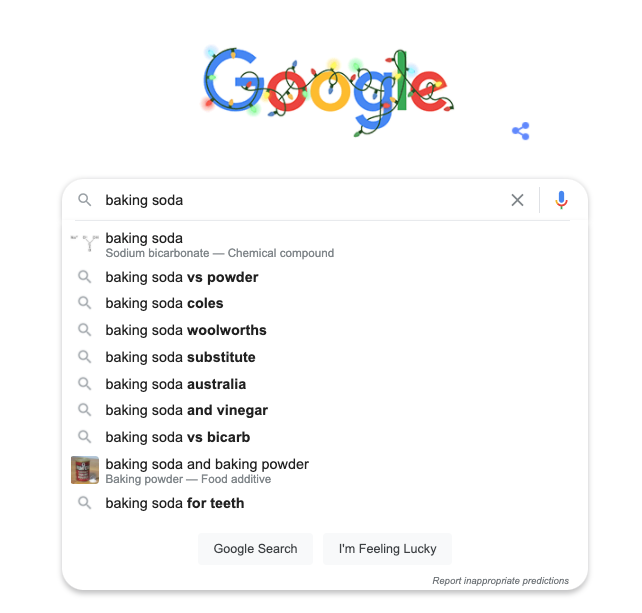
Let’s look at the search term “turnip” to see how MasterClass has dominated the SEO game.
Because Google likes to fulfill intent, the first page of the search will usually show you what people want to see. The easiest way to understand search intent is to have a look at the questions in the “People Also Asked” box. Below, you can see these questions (aka. search intent).
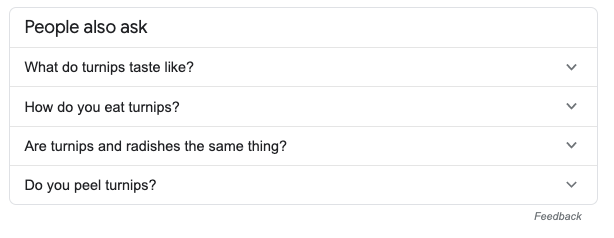
Check out which link is listed at number four on this search:
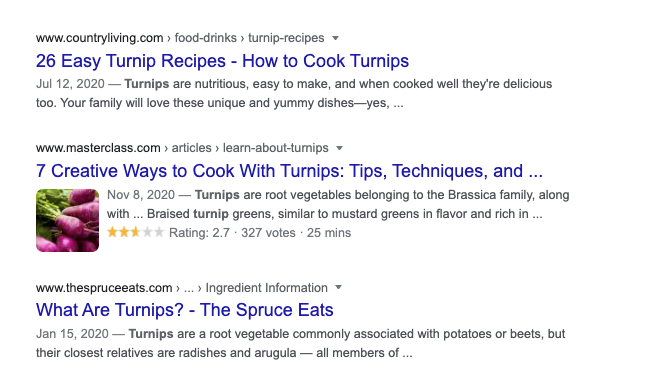
MasterClass has managed to create content that satisfies all of the suggested intent searches, and as such, gets a nice boost ahead of everyone else.
Impressive, right?
What MasterClass has done in its marketing strategy is to focus on search. They’ve put as much effort into their video production as they have for their content keywords and their search intent targeting to acquire organic traffic.
Continuing with our turnip search, this is the content they cover on that single page of “learn about turnips”:
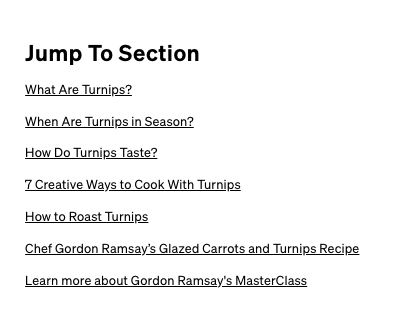
With these simple headers, nestled right at the top of the article to make them more SEO friendly, MasterClass has basically hit all the search intent points that we mentioned above and given their audience answers to questions they didn’t know they needed.
On top of that, they’ve included another killer ad from their Gordon Ramsey Masterclass. It’s pretty impressive that they’ve married content with SEO and search intent friendly keywords.
READ MORE: The Ultimate List of Every Tool You Need To Create Your Online Course
Utilize Course Platforms
There are a wide variety of online course platforms to choose from, with pros and cons for each of them. You can check out our full list here to learn about the different platforms and our recommendations for them.
These platforms are great because they give you access to:
Built-in Marketing
Online course platform’s revenue is dependant on the number of students on their platform. This means they pump huge amounts of money into paid advertising and SEO optimization. If you wanted to do an independent, self-published course, you would need to do all of this heavy lifting yourself (which is expensive if you’re new to the game!)
Large Audience/Student base
Online course platforms have thousands, if not millions of students. If you play the game right, your course could be picked up in the recommendation engine, and be seen by thousands of highly-targeted buyers.
Credibility
Many of these platforms have been around for a long time and have strong credibility. Hosting your course on these trusted platforms appeals more to buyers who prefer to purchase from a familiar brand, rather than an unfamiliar brand.
Community Support
Platforms are so dependant on the community they foster, they prioritize support communities for instructors and students alike. If your course is independently published, you don’t have this level of support if something goes wrong.
READ MORE: How We Validated 12 Online Courses Without Spending A Cent
When you don’t have an established following, online course platforms are a no-brainer for selling your courses. They do most of the heavy lifting for you and automate all kinds of marketing and sales for you. Platforms do require payment in some form or another, some upfront while some take a cut of your revenue, and this is payment for their services.
In order to make the most of the platform’s tools, there are little tricks and tips you can follow to make sure that you get the most out of your platform without paid ads.
Udemy
For this case study, we are going to examine selling a course on Udemy.
Udemy began in 2010 as an online course platform that had classes on making money playing poker and picking up women in bars. But when the founders, Eren Bali, Gagan Biyani, and Oktay Caglar, realized that coding and business skills were more in demand, they shifted focus from poker and women. Even today, web developing, coding, and business skill courses make up two-thirds of Udemy’s selection.
Today, Udemy boasts 35 million students across the world, with 400 million course enrollments. The platform is free for instructors to create their courses, and they can offer to sell their courses for a fee or for free. If an instructor decides to charge, Udemy takes a percentage of that.
When you host on Udemy, you’re up against 57,000 other instructors teaching in 65+ languages. The competition is stiff, but luckily, there are ways to make your course appealing to students that don’t require much work.
One of the top instructors on Udemy, Phil Ebiner, does a brilliant job of this
So brilliantly, that he is estimated to be hitting $1 million in revenue in 2020.
So, how did Ebiner rise up to become the best instructor on the platform? Let’s investigate.

Phil Eibner was just 22 when he decided to create his first course on Udemy: a guide to using Final Cut Pro editing software. He had a degree in video production, freelanced as a wedding videographer, and was working two jobs as producing marketing and instruction videos for colleges. With close to $100k in student loan debt, he dedicated some of his time to creating his first course.
In an interview in 2017, Eibner says that he put together his first online course where he taught others only what he knew, and what he was passionate about.
“I put [the course] on Udemy.com because that was the first place I heard that anyone could teach online. And luckily I made a few sales that first month, and I made sixty dollars.”
Eibner continued to create content to sell on Udemy, and he continued to gain students. He launched the third course, a fourth, one course on shooting with Green Screens, another one was a how-to on AfterEffects.
Eibner says that he “saw the power of having multiple courses on the platform and how they acted like individual streams of income that combined to a big stream…I kinda went crazy creating as many courses as I could.”
Over the years, he began to release his content on other course platforms, hosting content on Skillshare and offering free classes on YouTube as he became more and more established as a teacher of photography, but nothing came close to the reach he got on Udemy.
In 2020, he is the platform’s top-rated instructor with more than 2.1 million students worldwide, and 132 courses. Every single course he created was filmed at home on a Canon DSLR camera that cost him $3,000, and everything he edits is on his 2012 iMac.
Ebiner launched his online course without a following, and now he’s all but retired, dedicate a few hours a week to answering emails.
Who doesn’t love that?
Course Platform Marketing
When Ebiner started out, the online course market wasn’t as crowded as it is now, but over time he has continued to adapt his methods to stay ahead of the game.
Standing out from the crowd on course platforms isn’t as easy as it used to be. In a crowded market, especially one where anyone and everyone can create their own course, you need to prioritize the marketing of your course in order to boost brand awareness.
In fact, Ebiner says, “Definitely now more than before, marketing matters.”
Udemy, along with other platforms like Skillshare and Teachable, offers these marketing tools to every instructor:
- Course Landing Page to communicate the value of the course
- Coupons and course referral links to promote the course
- Promotional Emails: to market the instructor’s other courses to their students
- Bonus Lecture to market other courses and related products to students
READ MORE: How We Validated 12 Online Courses Without Spending A Cent
Course Landing Page
Your course landing page will consist of your course’s title, subtitle, course summary, instructor bio, and course goals. As an instructor, you can leverage this space to help convert potential students and help them see that you are the right course for them.
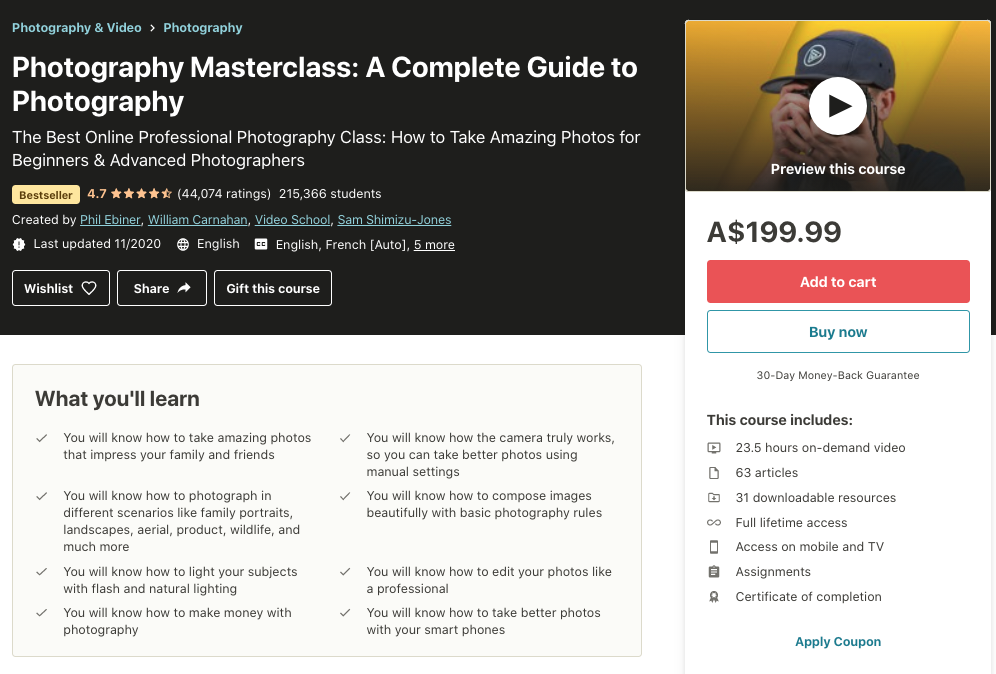
Ebiner’s landing page is clear, concise, and appealing to someone interested in learning photography.
The name of the course itself tells you right away what to expect, a complete guide to photography, and the subheading addressing the appropriate skill level for the course. In this case, beginner to advanced.
Use your course landing page to honestly communicate to the customer what they should expect from your course. This isn’t your opportunity to be mysterious or to be clickbaity. At the end of the day, if your course landing page isn’t inline with your course, customers will request a refund and move on to another course.
Promotional Emails
These promotional emails are a game-changer, especially as email marketing services usually cost a bit of money. Picture this: every new course that Ebiner launches is then emailed out to 2 million students worldwide.
Promotional emails are a goldmine for getting repeat customers to your course. Udemy allows you to send out promotional emails alerting existing customers of any new courses you launch.
Make sure you take advantage of this every time you launch a new course. This is how you get repeat customers!
READ MORE:The Ultimate List of Every Tool You Need To Create Your Online Course
Coupons and course referral links
On Udemy, every paid course has a referral link, which can be shared with as many people as you like. There is the option to participate in the “Udemy Deals Program”, where students who click your referral link can get additional bonuses like special discounts for new users.
Referral links are great when you want a more permanent method of gaining new students. You can put the link on your social channels, as a signature on your email, anywhere!
If a student clicks the link and makes a purchase within 24 hours, regardless of where the sale came from (eg. affiliate sites) you get to be credited with the sale and you receive 97% of the revenue share.
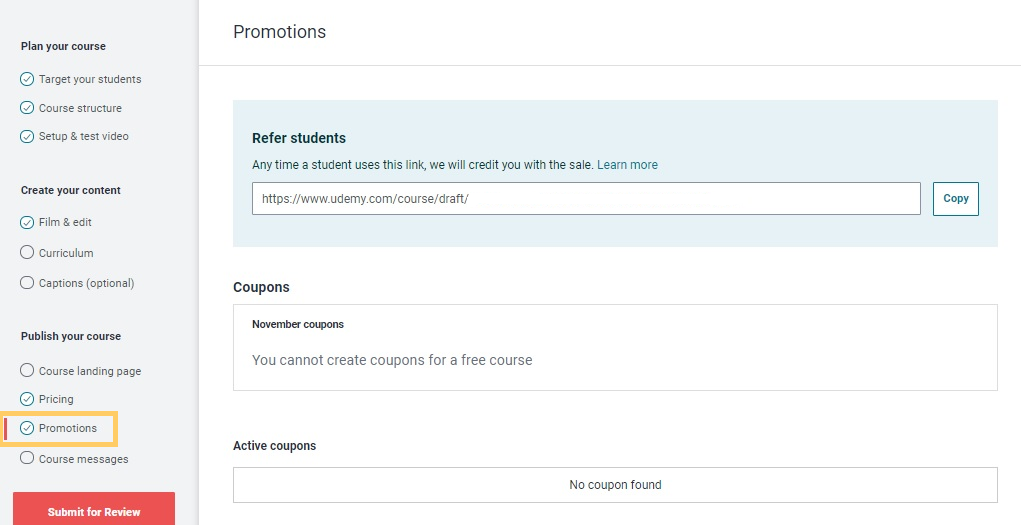
Another good option is “coupons”. You can also choose whether or not to do a discount coupon, which lets you set a promotional price for your course for 30 days. Coupons 93% of U.S. shoppers cite discounts and offers as important factors when deciding whether or not to purchase from a retailer or brand. It might be the little extra nudge your students need to make the purchase!
We think the best way to make more sales for your course with splashing out on ads is something that may seem a little counterintuitive: offering free coupons.
Bear with us on this one.
A free coupon is a way to give some lucky students free access to your course. You can send this code out to an unlimited number of people and is the ultimate way to build your brand and gain some traction in a competitive market.
At the start of 2020 and the sudden appearance of Covid, Ebiner decided to use free coupons for a number of his courses. “I just wanted to help people,” he says.
Within days, 3.5 million sign-ups poured in. Enrollments snowballed, and he saw a sharp spike in not only the free courses but for paid courses too. “It kind of went bonkers,” he says. His income in March 2020 alone hit $92k, more than three times what he earned in March 2019. In April, his best month ever, he made $109k, and he earned $102k in May.
All of this, and not a dollar spent on paid ads. Just by offering free (awesome) content.
Teachable also offers a great coupon system, in particular the Multiple-use coupons.
This kind of coupon can be used by a specified number of users (up to 1000) that have access to the coupon code. For example, if you create a multiple-use coupon with the code “NEWCOURSE” for 500 users, the first 500 users to use that code would receive 50% off their purchase.
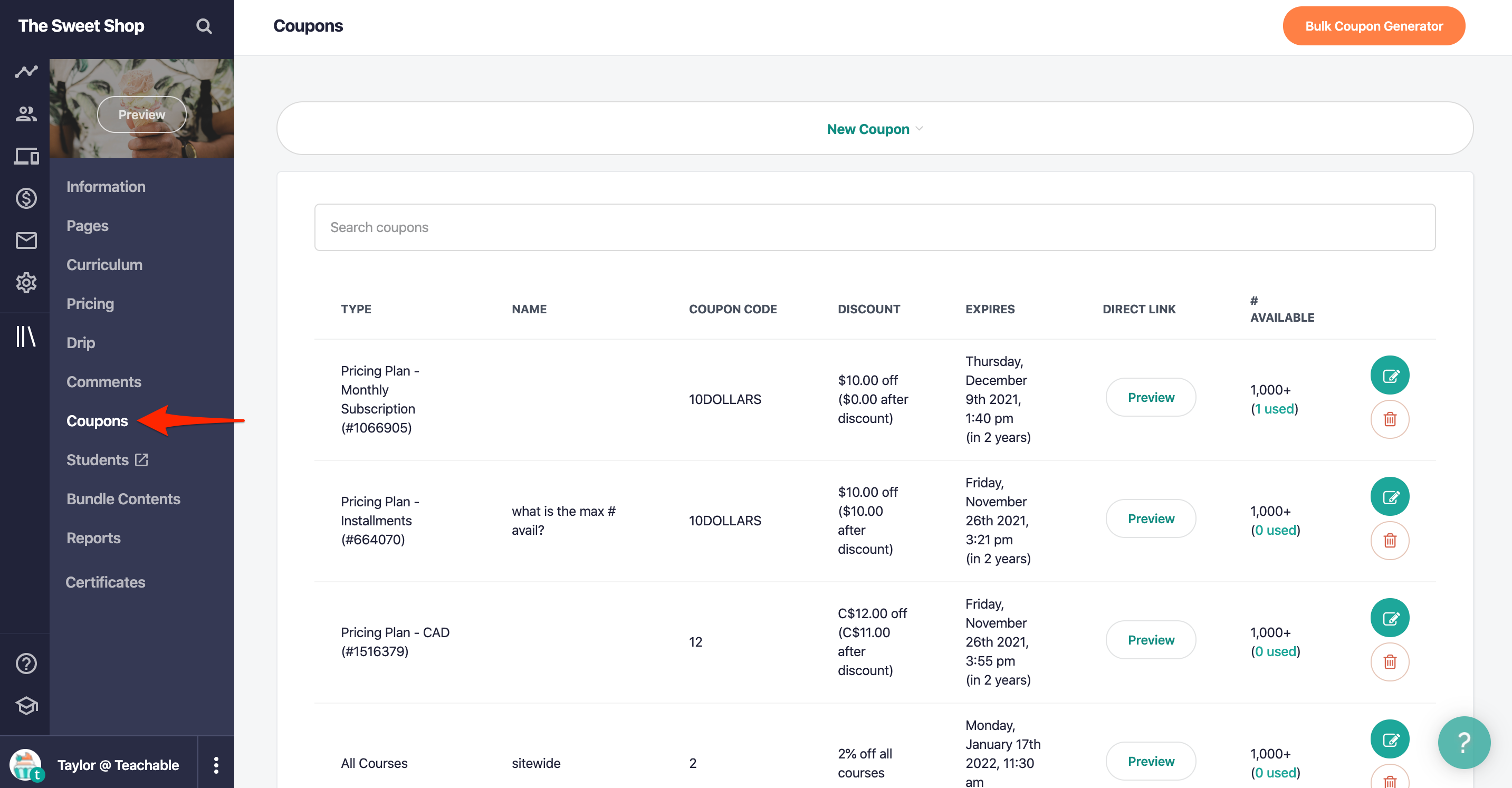
The easiest way to gain a following and get your course out there is by offering free coupons. If there’s no financial loss, people are usually willing to take a chance on an unfamiliar brand, and once they’re hooked, you’ve got brand loyalty.
Collaboration
The great thing about joining a platform is that you instantly gain access to its community of students and instructors.
Ebiner does frequently in his courses, partnering up with other instructors from Udemy. Take a look at this Adobe Illustrator course he recently launched with Adobe Certified Instructor & Adobe Certified Expert, Daniel Walter Scott. 
This collaboration opens the door to a different audience for Ebiner. He has experience with Adobe having launched several courses on Photoshop and AfterEffects, but this collaboration helps to establish him as an expert in other Adobe programs, especially as he is aligning himself with someone who is “Adobe Certified”.
In an interview in 2017, Ebiner said that he’s “also found other people online who have their own audiences already and create courses with them. That’s a great benefit, because when we launch a course then we have more of an audience to sell to….it’s definitely a benefit.”
Do your research with other competitors in your space, and with those who are just on the fringe of your expertise to see if you can collaborate on a course.
For example, if your course is on “caring for your indoor plants”, you could either collaborate with another indoor plant enthusiast or otherwise follow Ebiner’s example and find a crossover. Maybe you can collaborate with someone who does at home carpentry, and do a “how to build your own window planter”?
See what magic you can create.
READ MORE: How We Validated 12 Online Courses Without Spending A Cent
Facebook Groups
Facebook Groups are essentially a community on Facebook’s platform that people can join. Groups are built around common interests or goals and can be private or public groups. Many businesses use Facebook groups as a way to create a community for their audience.
More importantly, it’s a killer way for you to develop a following and sell your online course.
Facebook Groups and communities are on the rise. In 2020, Facebook reported more than 10 million groups on Facebook, with 1.4 billion people using them every month.
That’s insane.
In addition to that, in 2019, Facebook itself admitted to prioritizing content from groups over all others. “We have updated our algorithm to prioritize the Pages and groups we predict an individual may care about most.”
That means that anything you post in a group gets an automatic boost up the ladder on people’s feeds. And this boost is the easiest way to get a huge boost in organic traffic.
Let’s examine “iPhone Photo Academy”, a course by Emil Pakarklis.

The founder Pakarlis is a self-taught iPhone photographer. With absolutely no formal training or background in arts, his course has become one of the world’s leading iPhone photography classes.
With an active Facebook community of close to 80k students, Parkalis did this all without using an online platform. All he had was his course and heavy engagement on Facebook. Pakarlis is a great example of how strong engagement on Facebook can help you to sell your online course and build a following simultaneously.
First, let’s discuss how you can leverage Facebook groups that aren’t a community for your course, and how they can help you sell your course later on down the track.
READ MORE: How to Build a Profitable Marketing Strategy
Make Your Profile Professional
Is your Facebook profile awash with photos of your 21st birthday? Do you have a weird profile photo of a cartoon bird, and is your education institute listed as “The School of Life”?
Time to clean up that profile.
Your profile is the first page customers will click on when they see you interacting in different groups. Make sure it’s a good impression. Use a professional headshot as your profile photo, and set any personal posts to “friends only”.
Pay particular attention to your “About Me” and “Intro” sections. Again, Pakarklis does an excellent job of this. He has included a link to his website, an email address, and a professional headshot to boot.
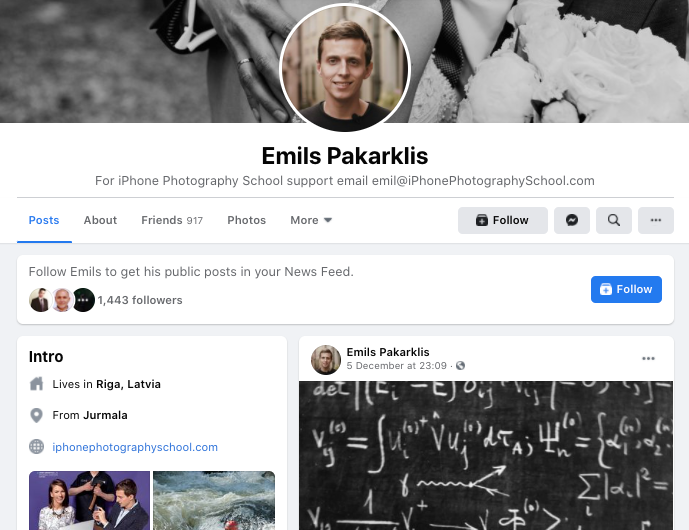
Find The Right Groups
What type of online course are you looking to launch? Are you launching a course on web development? What about conversational French lessons? Baking, sewing, personal fitness?
The first thing to do is to identify where your customers might be. Search through Facebook to find groups that might have prospective customers, and request to join them.
The great thing about Facebook groups is that they’re not strictly geo-limited.
For example, you may be looking for prospects for your “conservation research” course. While a Facebook group dedicated to the conservation of a small park in Texas might not have too many members from Bristol, UK, you can probably assume that someone in a “Protect Bristol’s Parks” group would have a common interest in conservation.
Have a shop around, and see what you can find.
Establishing Your Credibility
If you’ve ever been in a Facebook Group, chances are that over time you’ve slowly noticed the same people popping up again and again.
Maybe these people are the first to comment on every post. Or maybe they’re the person who starts discussions on topics.
Either way, these individuals are slowly establishing themselves as an authority in some way or another. By being an active member of the community, you’re showing an active interest in the subject and sprinkling some expert knowledge over the top. As tempting as it may seem, try not to dominate any discussion boards, or worse, get into any nasty fights.
You want people to remember you for your helpfulness and your expert knowledge.
Establish Yourself As A Community Member, Not A Salesperson
The worst thing you can do for your course is to spam posts about it in groups. Not only will people dislike you for clogging their feed, but can also make your course seem a little scammy.
Instead, start looking for any opportunities for you to demonstrate your level of expertise in that area. Be as helpful as possible, discuss methods with group members, and work towards becoming an informative and trustworthy source.
If you decide to post about your course, or even offer referral links or coupons, make sure that it’s not too sales-focussed.
READ MORE: How To Develop An Online Course
Groups For Your Course
Once you’ve launched your course, either independently or through a course platform, you can get started on building a community around it.
Your course’s Facebook group should be a safe space for students to discuss, interact, ask questions, and showcase their work. We have Facebook groups for every course at Foundr!
We suggest creating an exclusive Facebook group for your course students only. Recent data from the Sprout Social Index highlights that “40% of marketers view private communities as a top social trend to prioritize in 2021″, so don’t overlook this one. You can provide students with a link when they sign up for the course or ask them to “request access” to the group.
Parkarlkis’ iPhone Academy has grown to a community of almost 80,000 students. Not only does this scream exclusivity, but it also adds a level of legitimacy to his course: if 80k+ people have signed up, it must be legit.
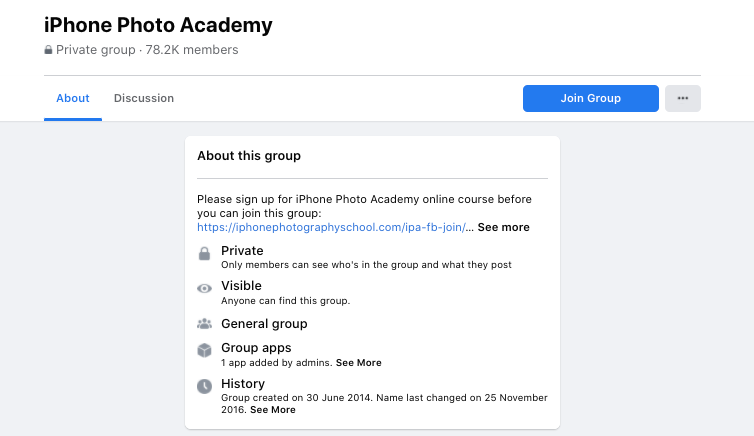
Facebook Groups Provide a Direct Line to Your Audience/Students
When you create a Facebook group for your course, you are essentially opening up a direct line of communication between you and your audience. Not only can your course members ask questions and flag concerns, but you can also use the group to make announcements, provide updates, and post customer surveys to students.
Here at Foundr, we use our course Facebook groups for announcements, discount codes, and more. We even do cross-course promotion, letting our students know when a new course is launching (and giving them a cheeky discount too).
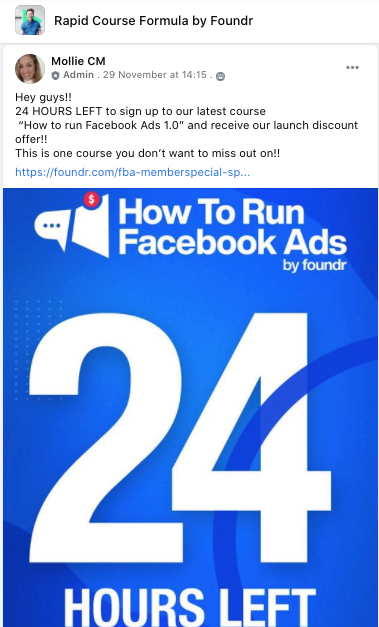
Try not to spam members too much, you don’t want the community to think they’ve signed up to be advertised to. Instead, use your Facebook groups as a gentle way to remind your community that you have something they may like.
Facebook Groups Allow You to Form Meaningful Customer Relationships
Facebook groups are all about engagement.
Groups allow you to create a direct line between you and your customer. Regular engagement helps to improve customer/course instructor relationships and doesn’t cost you anything.
Have a look at these statistics:
In a study reported by Forbes, 84% of respondents said that they trust online customer reviews as much as personal recommendations and that businesses that respond to online reviews quickly get positive reputation points.
In a study by Lithium, 72% of Twitter users expect a brand to respond within an hour of a negative Tweet. If the brand responds in a timely manner, 47% of respondents are more likely to recommend the brand through social media.
What this means for you is that engagement on Facebook, either within your group or outside it, equal publicity for your course. Take the time to reply to each and every comment (yes, especially the ones with negative feedback!) and you’ll slowly build more meaningful relationships with the community and loop in more customers.
Parkarlis is fantastic at building meaningful relationships with his students. The iPhone Photography team replies to all comments and even provide discount codes as a bonus.
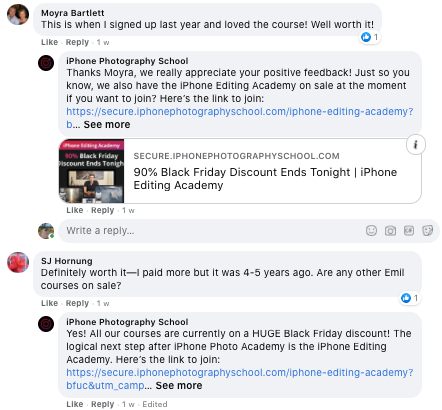
This kind of positive customer experience will do more for your course than any amount of paid ads will. When you like, comment, and interact with others, especially in your group, you’re helping to build credibility for your brand.
READ MORE: How Foundr Created it’s First Product Launch
Affiliates
For those who don’t know much about affiliate marketing, it’s a pretty easy and effective way to get your online course selling without money.
With affiliate marketing, you’re allowing other entrepreneurs, instructors, or key opinion leaders within your niche to start selling your course for you. When they deliver a visitor to your site and that person purchases your course, you pay the affiliate a percentage of that sale.
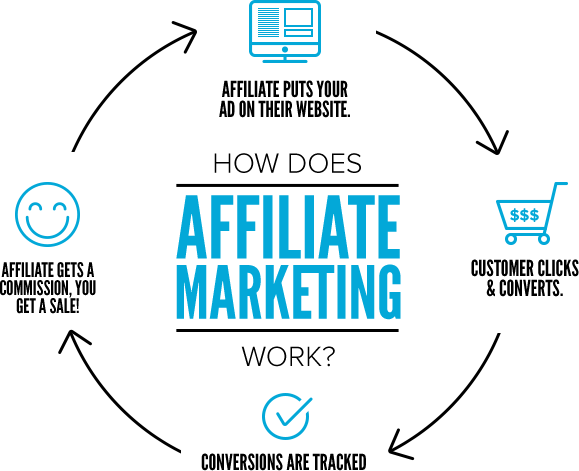
The amount that you decide to payout varies. It can be based on the price of your course, or it can be a price that encourages affiliates to work with you.
Most of the affiliates who end up sending traffic to your site in order to try to earn commissions from your course would not have sent traffic your way just out of the kindness of their own hearts.
Depending on commission, you may be losing 50-60% of your sale to your affiliate, but the truth of the matter is that they are bringing you traffic and sales you might not have gotten otherwise.
There are a few good reasons to consider working with affiliates.
Automated, and Easy To Organize
Setting up for affiliates is super easy to do, and once you have them signing up to sell your course it can feel like you’re making progress without even trying.
If you have a WordPress site, all you need to do is install and configure a plugin. You’ll need to have a way to make the payments to your affiliates, like Paypal, and the plugin does the rest for you.
There are a few plugins on the market you might want to check out, although they are priced:
Here at Foundr, we use Keap/Infusionsoft’s built-in affiliate program. If you’re using Teachable as your course platform (a partner of Foundrs!) they have a nice affiliate system inbuilt.
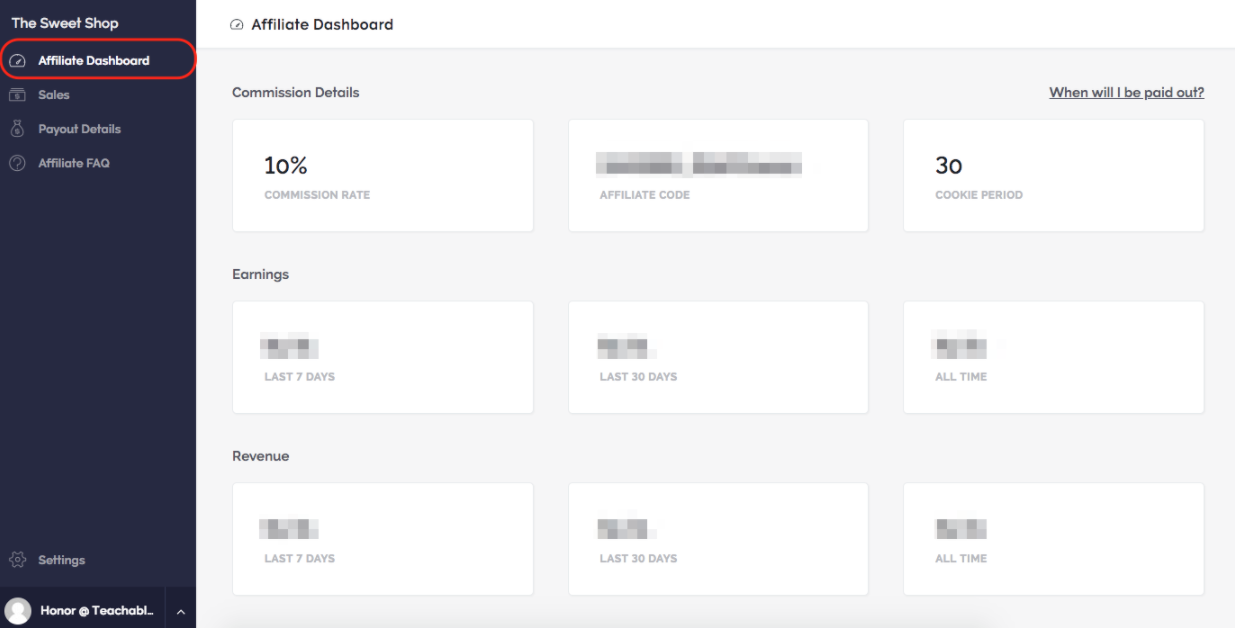
No Following Required
We love affiliate programs because you don’t need a huge pre-launch following to make sales from the get-go. An affiliate helps you to access an audience, which means you don’t need to do hours of intense market research to target them.
If you’re looking to sell your course without paid ads, affiliate programs can help with that. While your partner does make a small commission from the sale, the amount of traffic that they can generate is worth the payment.
If your affiliate generates a lot of interest for your course but doesn’t land any sales, you don’t lose any money (although you may want to find out why the sales failed to convert to look for areas of improvement).
KBB.com
Let’s examine KBB.
Knowledge Broker Blueprint (KBB) is an online course launched by Mastermind.com aimed at helping people run a successful business. The course is best well known for having Tony Robbins and Dean Graziosi at the helm, and their clever use of what they called the “partner” program.
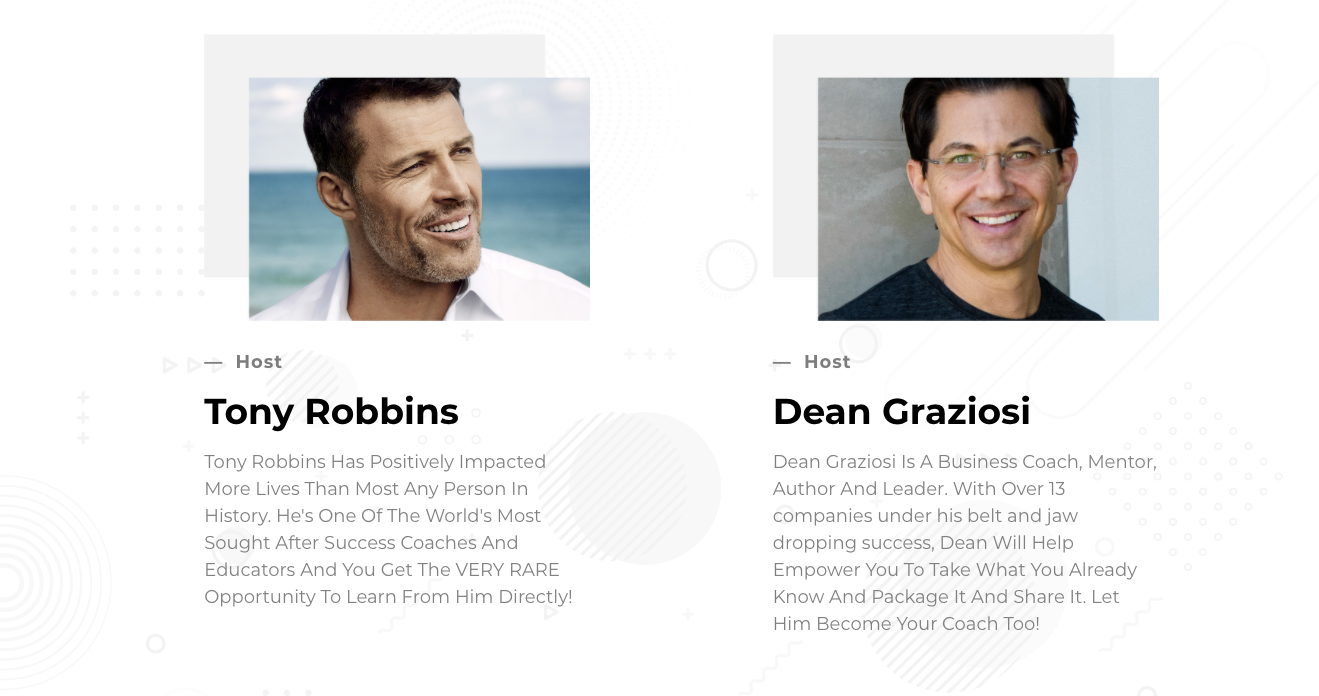
Just like MasterClass, the big pull for this course is the names. I mean, who doesn’t want to learn from the best of the best?
But what truly sets this course apart from the rest is more than just big names. The real drive behind this course’s success is the incredibly successful affiliates or “partner” program. It allows people to earn commissions by referring customers to purchase the “Knowledge Business Blueprint” course.
Mastermind.com encourages you to share referral links, encouraging partners to promote “Tony and Dean’s livecast training on social media, sending emails to your list, sharing with your personal network, placing links and promotional banners on your web site, running paid ad campaigns, or other innovative ways.”
When someone successfully refers someone to the course, they earn a 50% commission. The program is offered in two payment plans, either one payment of $1,997 upfront, or four payments of $597 over 90 days.
Not bad money for just sending your email lists a link.
As you can imagine, the internet went wild. Blogs, websites, influencers, everyone suddenly had content dedicated to promoting KBB as a way of side-hustling.
But money wasn’t the only incentive for affiliates. In 2019 Mastermind had a full-blown leaderboard, tracking sales. After the launch of the course, the top 10 leaders along with Tony Robbins and Dean Graziosi were taken to Fiji for a celebratory holiday.
Mastermind says that their first launch alone made $40m, with a rough estimate of $15+ million dollars being paid out to affiliates. It’s reported that 384 affiliates had at least one sale, 20 affiliates had at least 100 sales, six affiliates having at least 500 sales, and most impressively, one affiliate had 1000+ sales.
Mastermind improved the sales for their course by offering an incentive to others to sell it to their lists. Affiliates motivated to make their own commission, worked hard to market and sell the course to their audience. Those who purchased the course used their learned skills to then go on and become an affiliate themselves.
At the end of the day, it was a three-way win: Mastermind sold their course and increased their reach, affiliates got compensation for their sales, and the course members gained knowledge.
When you’re looking to gain some traction for your course, heading down the affiliate route is a great place to start. Not only can it help you to gain some more customers and sales, but it’s also an opportunity to do some sweet networking.
READ MORE: How to Create an Online Course Like Foundr
Choosing The Right Affiliates
When you’re choosing someone to partner with, pay close attention to their audience and engagement. Will their audience be interested in your course? Is their brand’s following authentic, or are they paying for bots?
You need to make sure that whoever is promoting your brand is promoting it to the right audience.
Take a look at the top 4 affiliates for Mastermind’s KBB. All the winners have access to the same audience that Mastermind is trying to tap into: business and startup education.

Strategy is Everything
When it comes to affiliate marketing, you need to ensure that your strategy is not simply spamming pages with links and hoping people will click through.
Michael Anderson, the founder of Passport Explored, notes that “one affiliate marketing idea that won’t work in 2020 is to aimlessly leave affiliate links throughout your website and hope that your audience will use them to purchase something.”
KBB has this issue covered by providing each and every affiliate with clear templates and guidelines on how to market the course.
All of this content is still online (click here if you’re curious to see it all).

Remember that an affiliate program is supposed to benefit you and your course. Don’t let an affiliate bully you into different payments you’re not comfortable sharing, and always do your research to make sure they can back up the goods.
READ MORE: Entrepreneurs Who Are Killing it With Online Courses
In Summary
There you have it!
The secret to selling your online course without using paid ads, and without a huge tribe of followers to sell to. Selling your online course without a following and without ads is possible with a little hard work and the right tactics.
Get your course out into the world by working on your SEO and search intent game. Use every tool in the course platforms toolboxes, and make sure you’re marketing your course the right way. Paid ads aren’t the only way to get your course in front of the right people!
Be friendly and helpful in Facebook groups, and make your very own group for your course members to connect with you. Affiliate programs are a no-brainer: sales on autopilot? Yes, please.
Which method do you think works better, paid, or organic ads? Let us know in the comments below!
The post How To Sell Your Online Course Without Paid Ads Or A Following appeared first on Foundr.
via https://AiUpNow.com December 14, 2020 at 11:02PM by Perrie Kapernaros, Khareem Sudlow,
